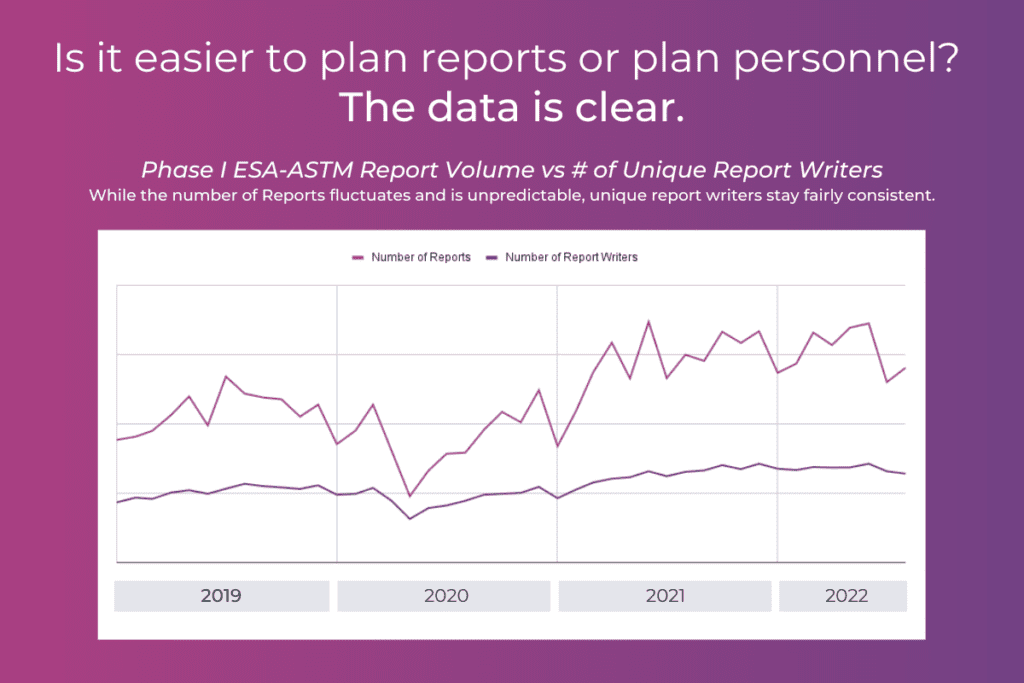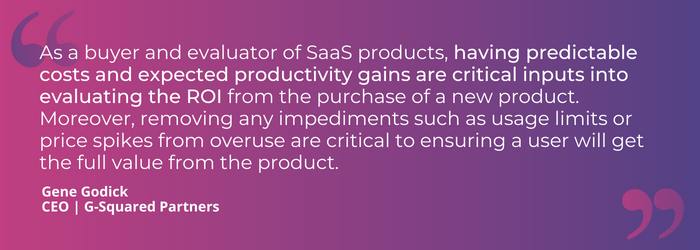You’ve recently come across a new SaaS (software as a service) product with an appealing offer: unlimited users under one license. You’re not yet certain who from your organization will need to use the software, so this sounds like an ideal pricing model.
But there’s a catch. “Unlimited users” does not mean “unlimited everything.”
Most likely, the software you’re looking at charges via an output-based model. Take technical report writing software, for instance. The “output,” in this case, is each technical report your team produces. While Quire’s technical report writing solution prices per User, other software providers may charge per report.
So which is truly the better fit?
Let’s take an in-depth look at these two SaaS pricing models for technical report writing.
1) Planning personnel vs. planning report volume
Quire’s research shows that the volume of reports a company writes can vary drastically throughout the year. For example, when considering commercial real estate (CRE) due diligence reports, which typically accompany real estate transactions, the data indicates that these report volumes not only follow seasonal ebbs and flows every year, but they are also impacted by other market factors, such as interest rates and supply/demand pressures (not to mention global pandemics).
When you purchase technical report writing software with unlimited User licenses (report-based pricing), you will, in turn, be limited in some other area. That limit is defined by output, in this case, the number of reports you create. You will purchase the software license for a limited number of reports based on your best guess as to how many you’ll need over an extended period of time (e.g., one year). That means a higher likelihood of:
- Underusing your license and paying for unused reports, or
- Overusing your license and getting hit with unexpected charges for “excess” reports, and
- Additional Account monitoring to ensure test Reports, canceled projects, and projects on hold aren't counted toward your total Report output.
In contrast, user-based licensing for technical report writing software means that you’re charged for the number of people granted access to the software. So, no matter how many reports users generate, no matter how many product lines are served, you’re only paying for the number of active users in your account. User access can change on a month-by-month basis. That way, if business fluctuates, your costs can adjust to reflect market conditions.
In the end, it’s much easier to plan personnel needs than it is to plan report volume.

2) Capitalizing on the efficiency of a technical report writing solution
The point of technical report writing software is to make your team more efficient. With features like intuitive templates, easy-to-insert dropdown values, and company-approved formatting every time, you should be able to drastically reduce the amount of time it takes your staff to produce each technical report.
User-based models (with unlimited reports) promote broad adoption across report types, magnifying the benefits across all service lines. Each user licensed to use the platform can create as many reports as needed of any type–from ESAs to PCAs to geotechnical reports to proposals.
With a user-based pricing model, you have much more flexibility to:
- Take on extra work during peak reporting seasons without worrying about exceeding your limits.
- Take advantage of increased efficiency by incorporating more of your company’s service lines without extra costs.
- Maximize the investment of onboarding and training your users by unleashing their productivity gains across an unlimited number of report types.
In output-based pricing structures, report volume is limited. Report numbers are notoriously difficult to predict. It’s likely you’ll significantly overestimate (or underestimate) the volume of reports, triggering a re-negotiation of terms in the midst of your contract. This leaves all negotiation power in the hands of your software vendor.
An output-based or report-based pricing model really only works when you can consistently and accurately predict your report writing needs. This can ultimately hinder your team’s broader adoption of the platform across other service lines that could be leveraging the benefits of a report writing software.
Here’s what Gene Godick, CEO of G-Squared Partners, a financial and operational consulting company specializing in SaaS technology businesses, had to say:

3) VOLUME LIMITS LEAVE MONEY ON THE TABLE
Output-based pricing naturally establishes a dollar value fee for each report. In order to make the most of output-based pricing, you’ll need to calculate the cost of the reports you’re writing and find equivalent value report types that would warrant the cost of using the platform. However, if there is limited work at that value level, your account may remain idle or underutilized. While all of your mission-critical technical reports may benefit from report writing software, not all may qualify based on the fee per report. No-brainer efficiency gains are traded for bogged-down accounting exercises.
User-based pricing is a more flexible, manageable model that can save your company money and help your team be more productive on all reports, regardless of their size and scope. With this type of billing, you’re only charged for the people who are using the platform—not for what they’re producing.
User-based licensing also allows you to control costs in other ways. For example, if you no longer need a license for a particular user, you can cancel it and stop paying for it. With output-based pricing, on the other hand, you would continue to be charged for any unused reports even during hard times for your business.
While all models have pros and cons, user-based pricing gives you more flexibility to grow your team, optimize service lines, and scale your business (and have periods of downtime without worry). For more information about Quire’s technical report writing solution and our user-based pricing model, reach out to our team!
